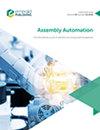生成装配计划时的工具工作空间考虑因素
IF 1.7
4区 计算机科学
Q3 AUTOMATION & CONTROL SYSTEMS
引用次数: 5
摘要
目的在新产品的设计过程中,装配序列图的生成已成为研究人员关注的重要问题之一。事实上,一个好的安装订单可以减少装配过程的时间,从而降低生产成本。在此背景下,研究人员开发了几种基于各种标准生成和优化ASP的方法。虽然本文旨在提高ASP的质量,但有必要增加在生成ASP时必须考虑的标准的数量。设计/方法/途径本文提出了一种基于三种主要算法的ASP生成方法。第一种方法基于稳定性准则生成一组装配序列。采用基于装配工具工作空间准则的第二种算法对得到的结果进行处理。用一个说明性的例子来解释这种方法的不同步骤。并进行了对比研究,以突出其优势。结果:该算法验证了每个装配序列所需的最小工作空间,并消除了不符合该标准的asp。最后,对剩余的装配序列进行第三种算法处理,以减少装配过程中AT的变化。原创性/价值提出的方法引入了AT工作空间的概念,以模拟和选择尊重这一标准的asp。动态干涉过程允许刀具与零件之间的最终碰撞检测并避免碰撞。该方法减少了安装过程中AT的变化。本文章由计算机程序翻译,如有差异,请以英文原文为准。
Tool workspace consideration for assembly plan generation
Purpose
During the design of a new product, the generation of assembly sequences plans (ASPs) has become one of the most important problems taken into account by researchers. In fact, a good mounting order allows the time decrease of the assembly process which leads to the reduction of production costs. In this context, researchers developed several methods to generate and optimize ASP based on various criteria. Although this paper aims to improve the quality of ASP it is necessary to increase the number of criteria which must be taken into account when generating ASPs.
Design/methodology/approach
In this paper, an ASP generation approach, which is based on three main algorithms, is proposed. The first one generates a set of assembly sequences based on stability criteria. The obtained results are treated by the second algorithm which is based on assembly tools (ATs) workspace criterion. An illustrative example is used to explain the different steps of this proposed approach. Moreover, a comparative study is done to highlight its advantages.
Findings
The proposed algorithm verifies, for each assembly sequence, the minimal required workspace of used AT and eliminates the ASPs non-respecting this criterion. Finally, the remaining assembly sequences are treated by the third algorithm to reduce the AT change during the mounting operation.
Originality/value
The proposed approach introduces the concept of AT workspace to simulate and select ASPs that respect this criterion. The dynamic interference process allows the eventual collision detection between tool and component and avoids it. The proposed approach reduces the AT change during the mounting operations.
求助全文
通过发布文献求助,成功后即可免费获取论文全文。
去求助
来源期刊

Assembly Automation
工程技术-工程:制造
CiteScore
4.30
自引率
14.30%
发文量
51
审稿时长
3.3 months
期刊介绍:
Assembly Automation publishes peer reviewed research articles, technology reviews and specially commissioned case studies. Each issue includes high quality content covering all aspects of assembly technology and automation, and reflecting the most interesting and strategically important research and development activities from around the world. Because of this, readers can stay at the very forefront of industry developments.
All research articles undergo rigorous double-blind peer review, and the journal’s policy of not publishing work that has only been tested in simulation means that only the very best and most practical research articles are included. This ensures that the material that is published has real relevance and value for commercial manufacturing and research organizations.
 求助内容:
求助内容: 应助结果提醒方式:
应助结果提醒方式:


